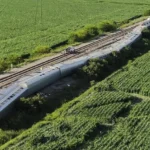Tough Job: Freight Engineer.
Over the past several months, I’ve been spending much of my days working on a fifth edition of my book on train travel. What really surprised me was the information I was gathering on the bigger subject of railroading in general and, specifically, some serious misconceptions I had about freight trains.
I had always assumed that the engineer sitting at the controls of an Amtrak locomotive, speeding along its route at 80 miles an hour, was a job that required a vast reserve of knowledge and skill and that, by comparison, the engineer of a lumbering freight train had little to do but constantly make the transition from SLOW . . . to SLOWER . . . to STOP.
I have seldom been more mistaken about anything. Consider the following numbers.
The length of an average freight car, including the coupling device, is about 65 feet. Let us assume there are 180 cars on our train. That means our train is almost 11,700 feet long . . . which is about 2.2 miles.
What about weight? Well, on average, a loaded freight car weighs as much as 130 tons. So, for 180 cars, that could be more than 20,000 tons. And let’s further assume there are three locomotives pulling this train, each one weighing 225 tons.
So now we have a freight train that’s two miles long and its total weight is almost 24,000 tons.
But there are more factors the freight engineer has to consider. To our eyes, his train appears to be traveling over flat terrain, but he sees it quite differently: he’s starting to climb a slight grade and has to prepare for what happens when his train starts down the other side of a little hill that we can’t even see.
When the front part of his train starts down hill, it’s being helped by gravity. But the other part of the train—the rear part—is still coming up the little hill. So the engineer has to think about having to gently applying the brakes go slow part of the train and, at the same time, needing to pull the rear half of the train which is still climbing up that little invisible hill.
Of course there’s one more little complication: the part of the train that needs braking and the part of the train that needs pulling . . . the number of freight cars in each of those parts keeps changing!
But don’t screw up, putting too much stress on one of those 180 couplers. Because if you “break” your train more than your boss thinks should happen, you may be looking for another job . . . an easier, less stressful job. Maybe as an Amtrak engineer.



I have a friend who was both an freight, Amtrak, and a Sound Transit engineer. He’s the man who gave me my one and only cab ride. I’ve never heard the job of the freight engineer explained so succinctly as in this column. I plan on forwarding it to him. Thanks for another great read.
I’ll be interested to hear his response. Let me know, please. Especially if he finds a lot wrong with it!
Use my email address: jploomis@maui.net. Thanks!